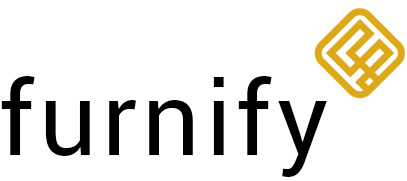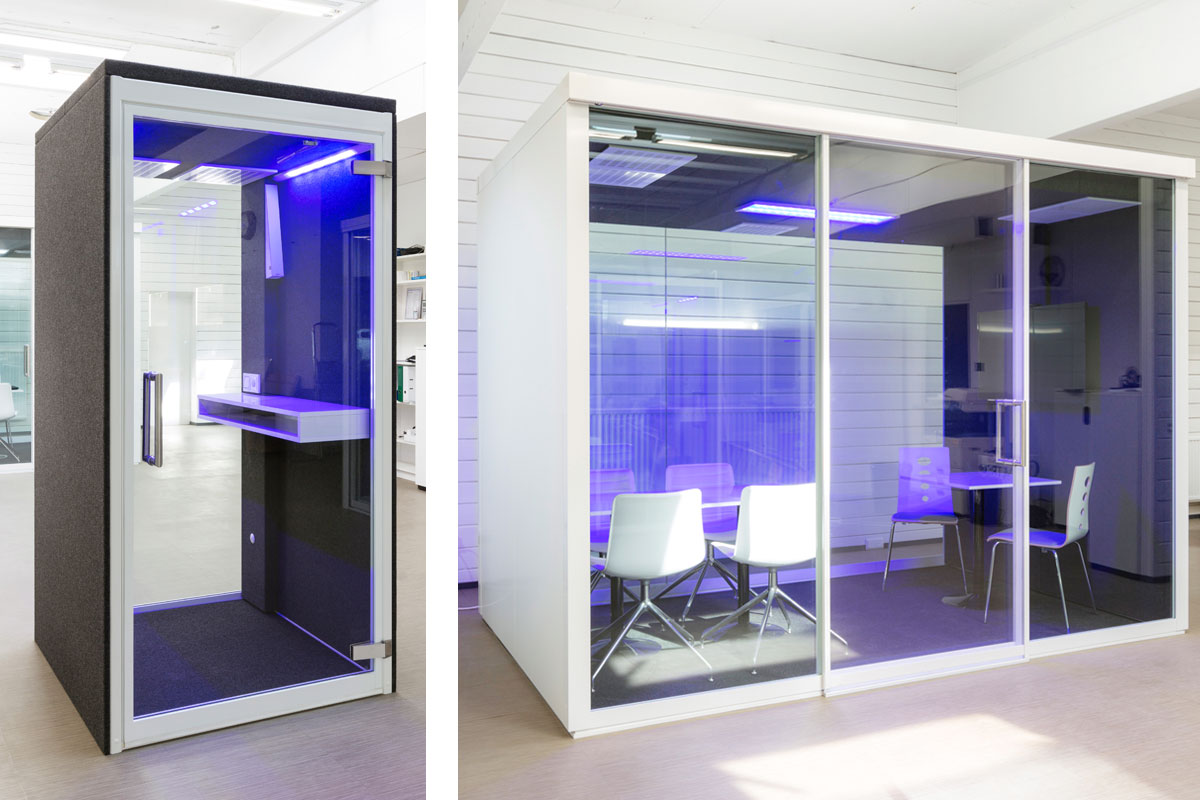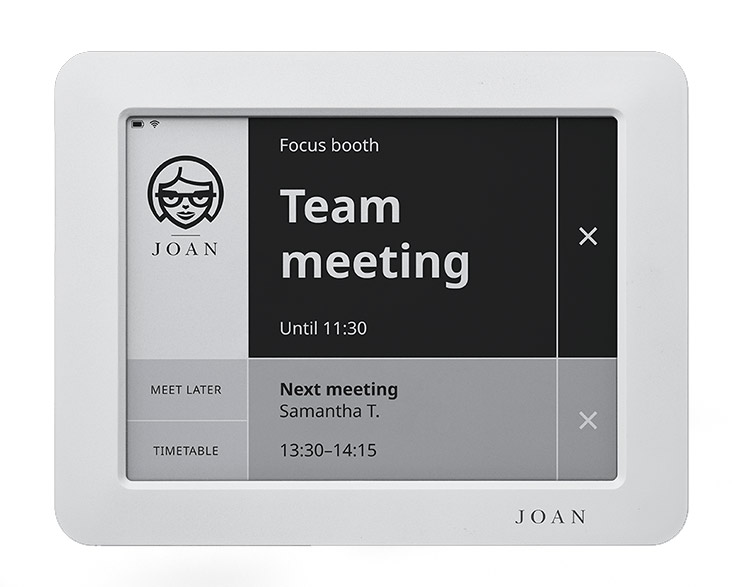Workplace design trends are accelerating quickly towards agile, hybrid offices. Before COVID-19 office work pods and booths were sought-after refuges from distraction. Silence and privacy were needed for focussed work and uninterrupted video conferences. Now, in a post-COVID world, the same office pods are ideal for keeping your employees safe from the coronavirus.
Few things drive you up the padded wall faster than obsessively worrying whether that thingy you just touched might carry an infection. And it certainly doesn't help when that particular colleague sniffs every time he walks past your desk after his toilet break.
Booths, such as semi-enclosed work booths, acoustic office phone booths and work pods, give employees a controlled environment where a sense of security can help them focus on the task at hand. And booths are essential if everyone and their dog is on Zoom video conferences with clients and colleagues working from home. But are booths safe?
Yes.
The End.
Weeeeell… Unfortunately, it is not that easy. Office booths and office pods are certainly much safer than your average open office. Being enclosed spaces, they are easier to control, and once they are clean, they stay clean until they are used. But they are still subject to user exposure, so in this article, we are taking a hard look at choosing and maintaining a hygienic office pod.
How to Choose a Safe Office Phone Booth or Work Pod during COVID-19
So, you have the furnify office pod web page open. You know the difference between pods and booths. You understand your noise-cancelling requirements and feel comfortable that you have an ideal zero-construction, easy-to-install choice. Great!
Now, the big question… which booths and pods are the safest options to use while maintaining a COIVD secure workplace?
There are two major considerations—your choice of materials and a good ventilation system.
Material Choices
The walls, floor and desk of your office pods should be either easy to clean, or actively killing the coronavirus.
The Sars-CoV-2 certainly sticks around on smooth surfaces. In a BBC article, Richard Gray says an "NIH study found that the Sars-CoV-2 virus survives for longer on cardboard – up to 24 hours – and up to 2-3 days on plastic and stainless-steel surfaces." The truth is, not much is known about the surface persistence of Sars-CoV-2, but there are studies on its relatives, SARS and MERS, that have clocked 5 days on glass, and up to 9 days on plastics.
Plastics, glass, and stainless steel happen to be pretty popular construction materials. On the one hand, it's a problem, because the virus can hide on hard surfaces for days. But on the other hand, they are relatively easy to wipe down with disinfectant.
When you do choose smooth surfaces for your pods, establish a rigorous set of cleaning rules (See Below)
Another option is to choose materials that actively fight the virus. Cell Pod Meeting Pods are constructed using a modular panel system. Instead of traditional MFC, translucent PVC or glass, you have the option of using upholstered fabrics for your wall-panels. Although little research is available, fabric proves to reduce the active life of the virus.
"So far, evidence suggests that the virus does not survive as well on a soft surface (such as material) as it does on frequently touched hard surfaces like metallic elevator buttons and door handles," says Dr Lisa Lockerd Maragakis on Johns Hopkins Medicine.
For extra certainty, you can opt for particular anti-microbial fabrics by Panaz which use ShieldPlus technology. These electrostatically charged materials deactivate viruses and have been tested and proven effective against norovirus and coronavirus variants (other than Sars-CoV-2… obviously the WHO doesn't hand out samples of a pandemic causing virus for casual testing).
GRAPHIC – SHIELDPLUS three stages graphic from - Define My Space Anti-microbial laminates are also an option.
Anti-microbial laminates are also an option on CellPods and selected Define My Space screens. Added to the final resin bath during the manufacture of High-Pressure Laminates, the anti-microbial components are a cocktail of chemical elements that hinder the growth of bacteria and mould. Not all laminate additives are safe for humans, so don't just pick a product blindly.
Ventilation
Quality phone booths and work pods should have the option to include air ventilation and treatment systems that guarantee a high rate of fresh-air exchange.
"Simply put, the more fresh, outside air inside a building, the better. Bringing in this air dilutes any contaminant in a building, whether a virus or a something else, and reduces the exposure of anyone inside," says Prof Shelly Miller of the University of Colorado Boulder.
In her article How to use ventilation and air filtration to prevent the spread of coronavirus indoors, Prof Miller shares the fact that "The vast majority of SARS-CoV-2 transmission occurs indoors, most of it from the inhalation of airborne particles that contain the coronavirus."
Choose an office pod solution that comes with an excellent fresh air exchange or air treatment system. Cell Pods have an optional ceiling mounted air circulation systems that inject a constant stream of fresh air. In fact, of the 12 litres of air circulated into the pod every second, fresh air makes up 8 litres.
Fresh air to dilute the coronavirus is the first line of defence, but also be on the lookout for air conditioning systems that filter air before it is recirculated. With dual filtration, CleanSpace Phone Booths are a prime example using a HEPA filter to reduce bacteria and particle levels up to 99.9%.
How to Keep Your Office Phone Booth or Work Pod Safe, Clean, and Healthy During COVID-19
Hygiene
Like the plot of a bad zero-to-hero 80's action movie, High-Gene used to be the social media guy. Then disaster struck, and now hygiene is the unlike protagonist that is saving the world from the zombie apocalypse.
One of the best ways to protect your staff during the pandemic is to establish a solid set of ground rules for the use of booths and pods.
Implement an office pod booking system. If you already have a meeting room booking system, name your office pods, and add them to the system. This ensures traceability and will allow your cleaning staff to schedule a 15-minute wipe down four times a day. Neat booking solutions, like Joan, will let pod visitors to see and make bookings either at the pod door, or by using the integrated office booking system on their devices.
Keep a portable sanitation station at the door with disinfectant wipes and hand sanitiser. It will empower your employees to protect themselves. As a policy, make it mandatory for employees to wipe down the door handles, plug sockets, desk surface and the armrests of the office chair upon entry.
Prop the door open with a doorstop between users if the ventilation system does not add enough fresh air. Leaving the door open will help to dilute any contaminants that might be in the air.
Cleaning and Cleaning staff
Cleaning obsessively used to be a pretty clear sign that you might be sanitising away your sanity… oh, how the tables have turned!
A pandemic is a tough time for cleaning staff. Tasks like washing the work pod windows, used to be a once-a-week or even once-a-month exercise. Now they are expected to do it multiple times a day. Ensure they have the right tools, like quality window squeegees, that will make the task fast and easy.
Your cleaning staff should also be equipped with comfortable masks, gloves, and overalls that can be laundered daily.
Ensure custodial staff are briefed on essential items to wash and disinfect every day. Door handles, elevator buttons and the microwave are all items that are touched by multiple people multiple times a day and should be cleaned frequently.
Only one cleaner should be allocated to clean a specific work area and specific booths. This is to ensure traceability. Should someone in the accounting team test positive for COVID, roaming cleaners could spread the virus to other parts of the building. By allocating one cleaner to an area, the likelihood of the virus popping up elsewhere decreases.
Chemical Disinfectants
Use special cleaners for electronics and screens. Not many people know this but wiping your laptop screen or monitor with any ol' disinfectant is a BAD IDEA. Many monitors have coatings that prevent glare, and a single careless wipe with the wrong kind of chemical can be a costly mistake. Be sure to tell you people that, so they don't destroy your equipment.
Portable sanitation stations with disinfectant wipes and sanitiser should be present in most high-traffic areas in your office. Putting one by the door of the phone booth is also a great idea.
Leave a misting spray bottle with a surface disinfectant in every booth and pod. Employees will be able to sprits the surfaces before getting to work.
Disinfectant foggers come in many different sizes, from industrial harness mounted rigs to a spray can. A simple spray can with nozzle can effectively sterilise air and surfaces of an entire booth. But breathing in germ-killer on a daily basis isn't exactly the best idea. Be sure that the ventilation system in your pod replaces the air before the next occupant uses it.
UV Lighting
Germicidal lamps use UV-C in the 260-nanometer frequency range to decimate DNA, RNA and organic membranes. Hospitals have been using UV to kill viruses and bacteria for years.
Wheeling a high-powered UV lamp into your office work pods between users can sterilise the air and surfaces in one go.
Although it might be tempting to write REDRUM on the walls in UV marker to freak out the cleaning staff, these aren't the black lights from your local nightclub. Using handheld UV lamps requires protective clothing and visors. And UV lamps for sterilising entire rooms should only be used when there aren't any employees around. Quality systems are remote controlled and have proximity and motion sensors that switch off the lights if someone wanders into the area.
UV lamps are an effective way to disinfect surfaces without continually rubbing it down with chemicals. There are no toxic fumes, and a once-off investment can drastically reduce what you spend on chemicals.
An even easier solution is to get a CleanSpace Phone Booth with built-in, automated anti-microbial lights that activate when the booth is unoccupied. Their WiSDOM Air blue disinfection lighting technology is safe for humans but takes much longer than UV-C to sterilise surfaces.
BEWARE: There are hundreds of useless UV sterilisation wands on the market. Get something that is certified and operates in the correct UV-C spectrum. A product that doesn't do the job might lull you into a deadly false sense of security.


